You might not be able to retain every leaving customer, but you definitely can turn the customer churn into an opportunity to learn and improve.
How can you do that?
It’s easy – with customer exit survey questions that help you collect actionable feedback from churning customers and build a seamless customer experience for existing and new ones.
These questions are integral to the customer exit process and help make data-backed decisions. Using the feedback from churning customers, you can create proper cancellation flows, optimize your products and experience, and track other customers at the risk of attrition.
It all comes down to designing a targeted customer attrition survey to extract nuanced insights from leaving customers.
And we have all the ingredients to make that happen, as compiled in this blog. We have listed the best customer exit survey questions and templates for your exit campaigns. We will also discuss the tips and tricks to design good exit questions for customers and what to do with the churn feedback data in hand.
So, let’s build a complete feedback loop to mitigate customer attrition in your business.
What Is a Customer Exit Survey?
A customer exit survey or customer churn survey is a questionnaire that collects feedback data from customers who are leaving your business or canceling their subscription to a Saas-based product.
Customer exit survey questions aim to collect information on various aspects of the customer experience like:
- Customer satisfaction with products and services
- Reasons for discontinuing the services
- Overall product experience
- Areas of improvement
- Product issues and concerns
- Differences between your and competitor’s products
Here’s an in-product customer exit survey template we use at Qualaroo to collect feedback from churned customers:
This simple in-context survey helps to target leaving customers and collect important feedback for our retention teams.
20+ Customer Exit Survey Questions You Need to Ask in 2025
Let’s look into some professionally designed customer exit questions for your campaigns. You can mix and match different questions to build a targeted customer churn survey and collect desired data.
Measuring Overall Experience
- What were the issues that prompted you to cancel the subscription with us?
- Based on your overall experience, how likely will you recommend the product and services to your friends and colleagues?
- What problems were you able to solve with the [product name]?
- Where did the product lack the most?
- How satisfied are you with the products and services?
- What do you like the most about the [product name]?
- What do you dislike the most about the [product name]
- Is there anything we can do to make you stay with us?
- How can we make the products and services better?
- Please share any suggestions to improve the product.
- Would you reconsider our brand/products in the future? Please give a reason for your answer.
Running Competitive Analysis
- Are you using a similar product to [product name]?
- Why did you choose this alternative over [product name]?
- How did you find this product?
- Is the current product you are using better, the same, or worse than [product name] regarding quality, value for money, and features?
- What are the factors that played a role in your decision? (Select all that apply)
- According to you, what should be the ideal price of [product name]?
- According to you, who are the ideal customers for [product name]
Gauging Your Services & Processes’ Effectiveness
- Was our onboarding process easy to understand?
- How can we improve onboarding?
- How satisfied are you with the support services?
- Were they able to solve your issues quickly?
- How can we improve our customer service?
Customer Exit Survey Templates: Get Started in Real Time
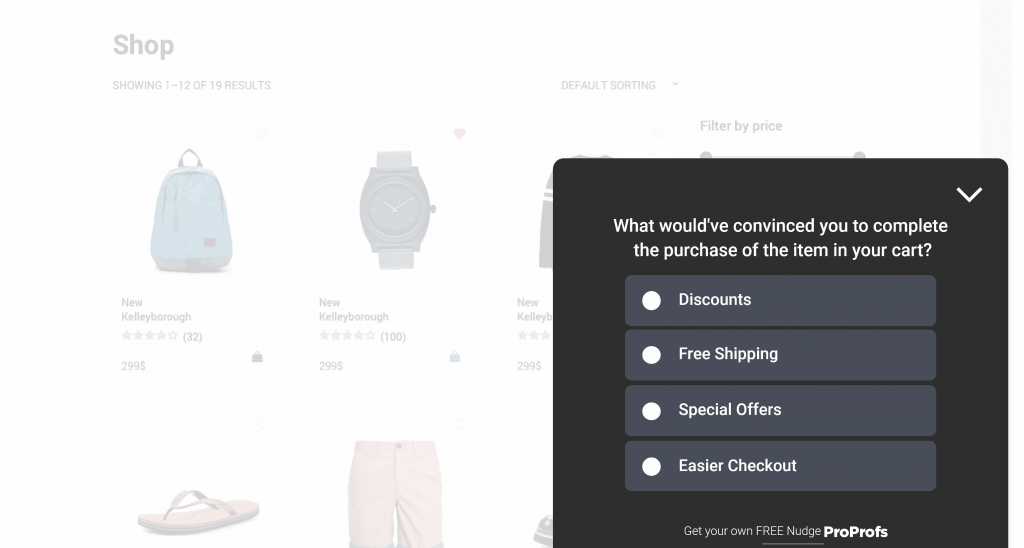
You can either create exit-intent surveys from scratch using the questions above, or you can choose to get started immediately with Qualaroo’s exit-intent survey templates.
These templates are highly customizable in terms of branding, font, colors, and questions you want to add or remove.
For example, you can use these templates and add more questions from above to make your surveys more rich.
You can also leverage conditional logic in these survey templates to collect in-depth customer feedback.
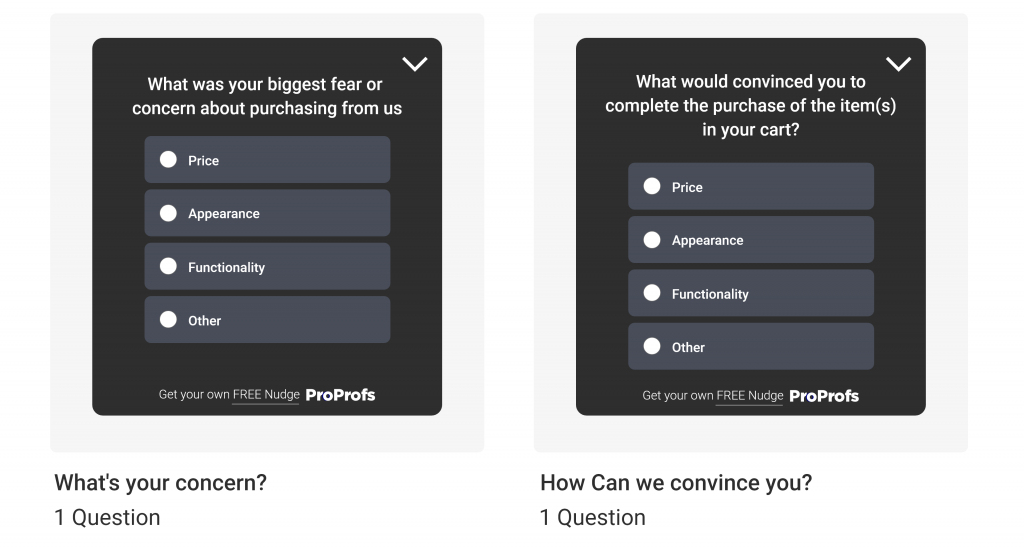
Check Out More Exit-Intent Survey Templates
How to Target Churning Customers: 3 Effective Channels
Churned customers are fleeing birds; you get one or two shots to target them before they are out of sight. So, picking suitable mediums to pose your customer exit survey questions is necessary. Here are some easily accessible channels to run your churn surveys:
In-Product
If you host a SaaS-based product, it’s better to use exit survey questions for customers within the product. You can add the survey to the page with the delete account or cancel subscription settings.
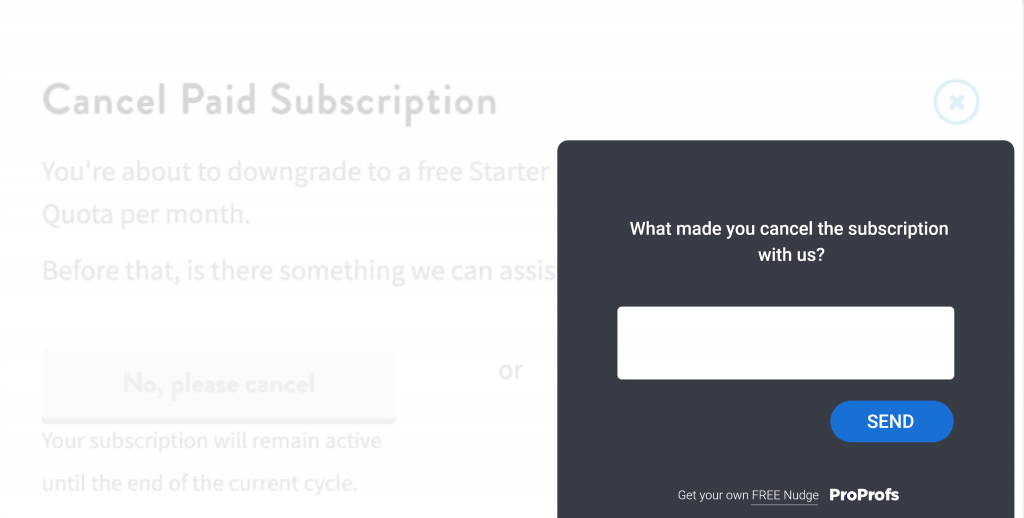
As we do in Qualaroo, set it to trigger when the user clicks the relevant tab and collect in-context feedback about their overall experience.

You already have your existing customers’ email addresses and contact information, so email makes a viable option for running customer exit surveys. When someone cancels their subscription, you can send an email survey using ProProfs Survey Maker to collect feedback and explore the reason behind the decision.
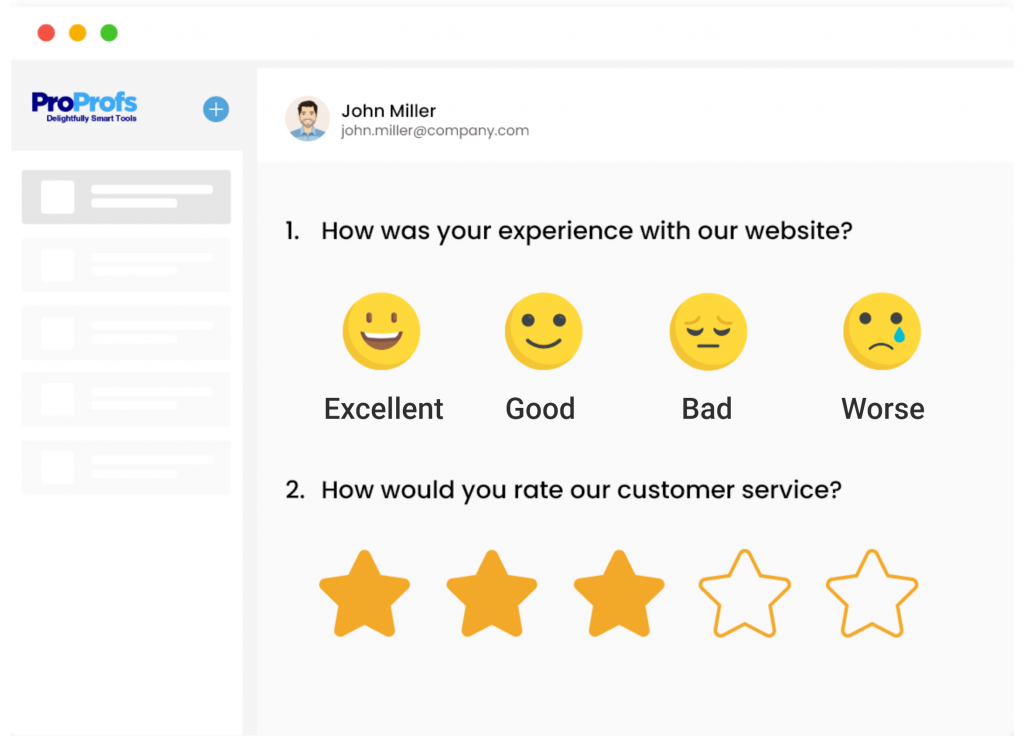
Design and save the customer exit survey email template in your feedback tool library, customize it for each customer type and send it to the user.
Email exit surveys are one of the best ways to target off-site users and are suitable for any business type – e-commerce, SaaS, in-store, etc.
On-Site Customer Exit Surveys
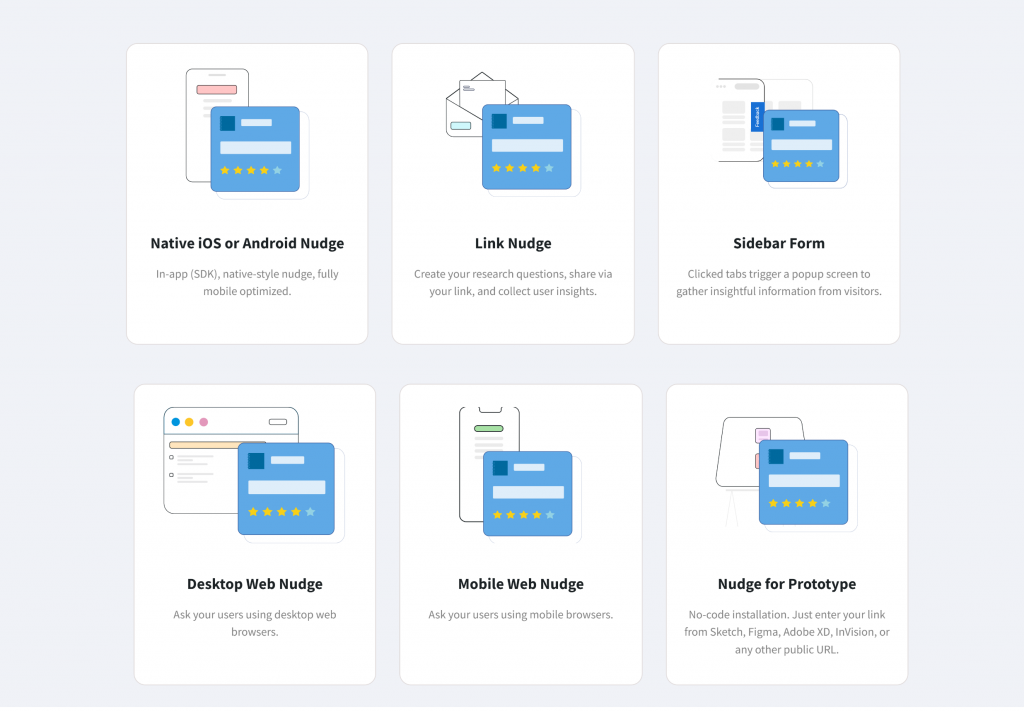
If you have an e-commerce website, on-site surveys can do the trick. You can embed these customer exit survey questions into the unsubscribe page or users’ account deletion path.
Use a tool that lets you set niche targeting options to trigger the survey when the customer clicks the unsubscribe button.
For example, Qualaroo provides built-in targeting options to fire the survey at the precise moment. You can also add custom trigger conditions as per your needs.
It lets you collect targeted contextual feedback from the users.
So, multi-channel targeting is an efficient strategy for tracking attrition.
However, monitoring so many avenues simultaneously seems a big undertaking, doesn’t it?
Not if you have the right tool!
Advanced survey tools like Qualaroo offer multi-channel survey deployment. It means you can target all three channels at the same time and collect feedback.
What’s more, it also provides built-in templates and customer exit survey sample questions to help you set up the campaign in minutes.
Then, you can collate the data from different surveys into one report and analyze the feedback quickly.
Read More: How to track and reduce customer churn in your business
FREE. All Features. FOREVER!
Try our Forever FREE account with all premium features!
Importance of Customer Exit Surveys
Let’s explore some reasons to conduct customer exit surveys in your business.
Open up Conversation
Close to 90% of customers want to provide feedback and suggestions. But over 50% believe the businesses don’t act on their feedback.
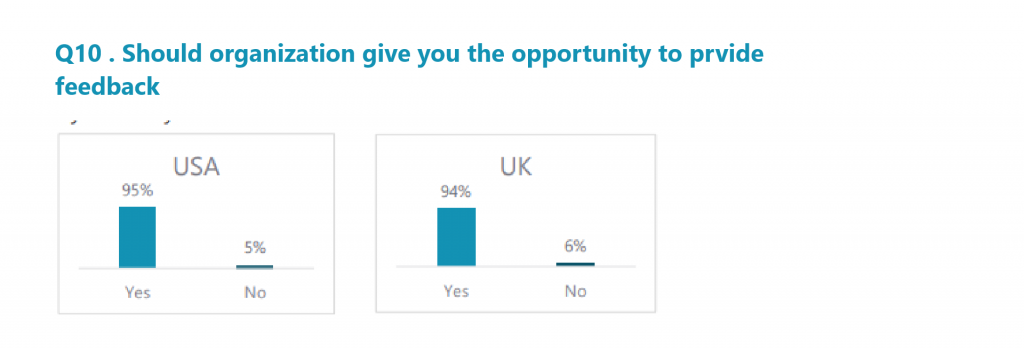
Customers want to speak their minds, especially those who are end of their ropes. You can fill this communication gap by asking simple questions.
Open up a conversation channel with leaving customers by using surveys to ask questions. You can review their feedback to understand their issues and then schedule a 1:1 meeting to discuss them.
It also shows that they are important customers worth retaining.
Identify Areas of Improvement
A survey is a cost-effective means to collect bulk data on customer experience, and customer exit surveys are no different.
With properly targeted customer exit surveys, you can reach out to people before they move to the competition and win them back.
You can combine this data with your periodic customer experience survey campaigns to identify the leaks and issues along the customer journey.
- Which touchpoints are missing?
- Which channels need to be optimized?
- What do the overall and transactional satisfaction scores look like from the start to the end of the customer’s association with the brand?
Read More: How to create detailed customer journey maps
Prevent Future Churn
The data of today becomes an insight for tomorrow. The power of customer exit surveys lies in the fact they can help you prevent future churn by identifying the patterns and concerns of leaving customers.
You can map these customers’ issues and extrapolate them on an organizational level to improve overall customer satisfaction and reduce the overall attrition rate.
Competitive Advantage
Apart from letting you map issues with your products and services, customer exit survey questions can find the gap between you and your competitors.
You can ask simple questions like:
- Why did you choose the [product name] over our products?
- What made you decide to go for the [product name]?
- What changes can we make to our product to convince you to stay?
- What are the three major features missing from our products?
- When compared to competitors, how does our product compare in the following aspects?
Now, you have in-depth insights from actual users. Use the data to optimize the products and outperform the competitors.
Resolve Critical Product Bugs
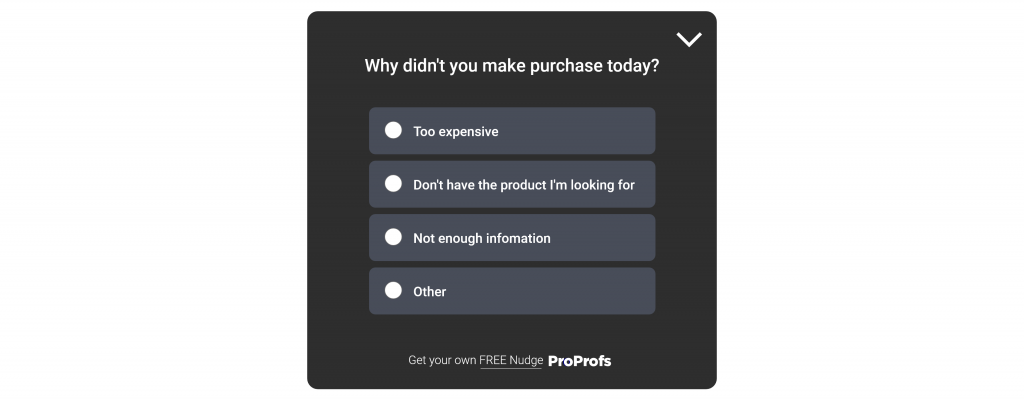
Customer exit can be due to multiple reasons:
- Unsatisfactory experience
- Lack of regular product updates
- Issue at checkout
- Broken user path flows
Some of these may affect individual users, while others can be critical bugs that can lead to a frustrating experience.
Customer exit surveys let you track such issues and fix them. Here’s an example of how a simple cart exit survey helped KingsPoint.
The company implemented exit surveys on the checkout to ask a simple question – What stopped you from completing your order today?
They discovered that a javascript issue did not allow the Firefox users to complete the orders. Compared to other browsers, the problem, if not found, would have cost them over $60000 yearly in revenue.

You can use the same exit survey on your cancellation pages to collect valuable data on churn and fix product-breaking problems.
5 Best Practices for Designing Customer Exit Surveys & Questions
Here are a few simple steps and exit survey best practices that can help improve response rates on your customer exit survey questions and connect with the leaving customer:
Keep It Short
Survey length can have a tremendous impact on your response rates and abandonment. But it becomes more critical when you are targeting existing customers.
A survey is another chore for customers in canceling the services, so why would they want to give their time and effort to fill out a lengthy survey?
You can optimize the survey length by two means:
- Keeping the number of questions to the actual required for getting the desired feedback data.
- Optimizing the time of completion
Here are a few pointers on managing the length of your customer exit surveys:
- List a set of topics you want to gain insights about from the leaving customers. Then, design the survey around the most critical issues.
- Look at past survey data and find the missing gaps in your feedback. Then add or remove the questions as required to fill those gaps.
- Use more multiple-choice questions to reduce the survey completion time. Add open-ended questions as follow-up questions to close-ended ones to gather more information.
Read more: Tips to write good survey questions
Last but not least. Test your survey before sending it out to eliminate redundant or irrelevant questions.
Use Branching Logic
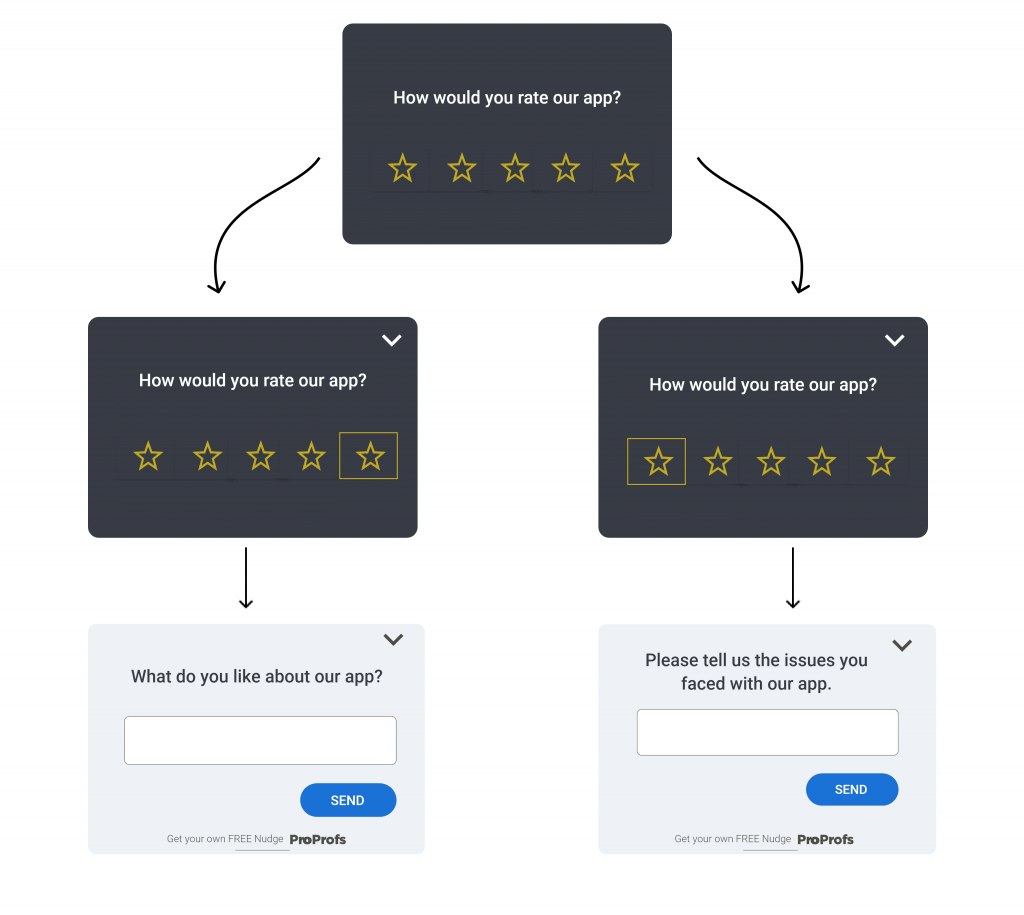
Another way to shorten the length and personalize your customer exit surveys is to use question branching. This simple feature shows different questions to the respondents based on how they answered the previous question.
Customers see only relevant questions based on their responses which can improve the relevancy of your feedback data sets and reduce frustration.
Plus, you are short on time as the customer would not want to stay longer than necessary when they have decided to leave the product. So question branching also shortens the time of completion.
Read more: A complete guide to skip-logic and question branching
Another advantage of a branched customer exit survey is that you can compare the feedback and concerns of different customer types.
You can use the survey to determine what issues or questions matter the most to different customer segments. From there, start improving the overall experience and reduce attrition.
Add a Net Promoter Score (NPS) or Customer Satisfaction (CSAT) Question
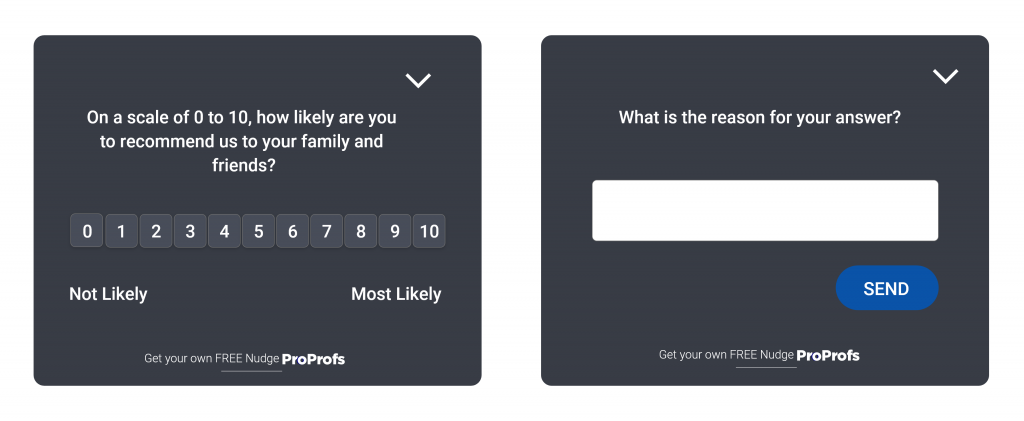
Adding an NPS or CSAT rating question to the customer exit survey lets you collect the customer experience (CX) score to get a complete view of the customer’s journey.
But why?
Because NPS helps gauge the likelihood of brand advocacy which translates into positive word of mouth, and CSAT lets you measure the customer’s overall satisfaction.
You can also compare it with the past NPS scores of the same customer to see how the ratings changed over time and spot the moments of frustration that may have led to churn.
Moreover, you can use it to refine your predictive analysis model (explained in the next section.)
Here’s how to make the most out of the NPS or CSAT question in your customer exit survey:
- Add the NPS as the first or second question to the survey.
- Based on the score, add a follow-up question (open-ended) to explore the reason behind the response.
- If the user gives a rating of 9-10 (promoter), request them to review the company/product on Google or other review sites.
- If you successfully retain the customer, rerun the NPS survey after a month to track the changes in the CX score and gauge customer satisfaction.
Use Language Auto-Translation
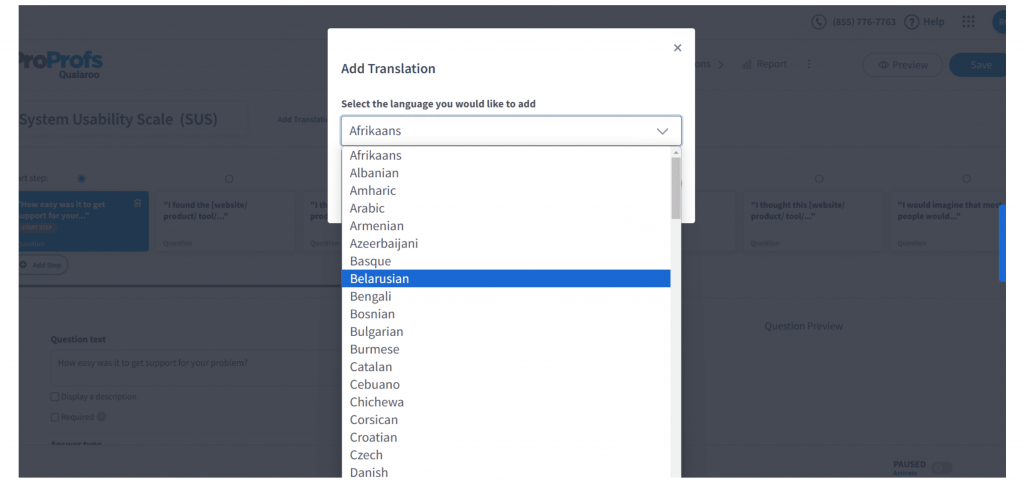
If you have customers from around the world, how would you ensure that all the customers understand the survey questions? Otherwise, you would get unreliable and poor feedback data quality.
With automatic language translation, you can display the customer exit survey questions in the customers’ preferred language. Many tools provide this feature to help you target different geographies.
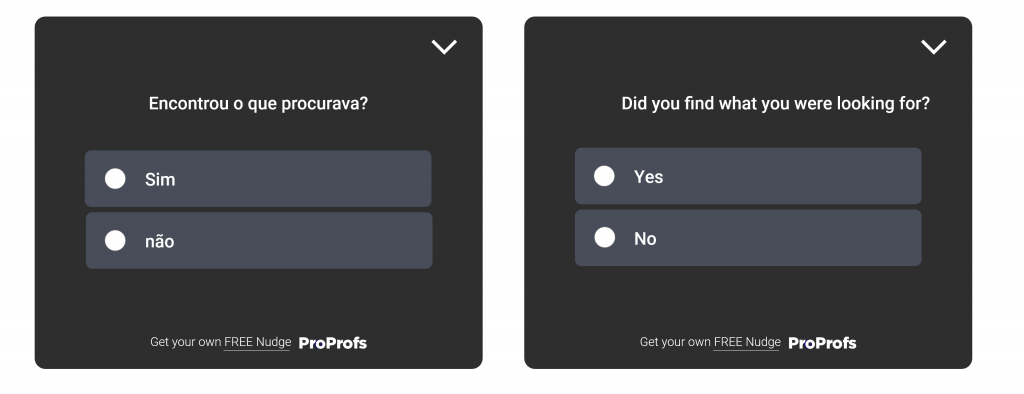
For example, in Qualaroo, you can select from over 100 languages when designing the survey.
Then, the tool automatically detects the browser’s language and converts the questions so the user can easily understand and complete the survey.
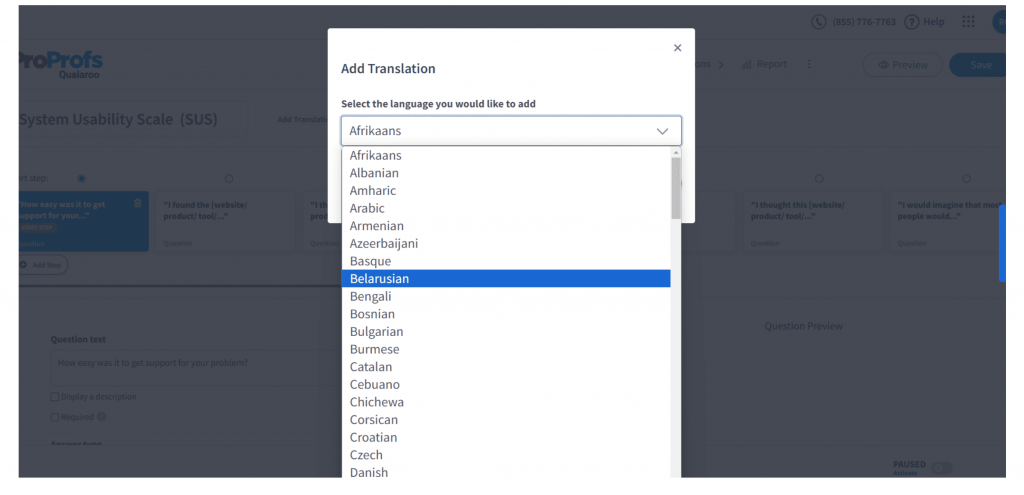
It’s a simple yet effective tool to make the most out of your customer exit survey questions.
A/B Test Your Customer Exit Survey Questions
Optimization never stops. Once you start getting feedback on your exit surveys, study the responses to determine if they provide the information you seek.
Then, redesign the surveys based on the insights.
You can then A/B test the new survey against the old one to see if it works better.
Many tools provide integration APIs to connect your feedback and testing tool and run the experiment.
For example, you can connect Qualaroo with Optimizely to test and optimize the surveys on any page.
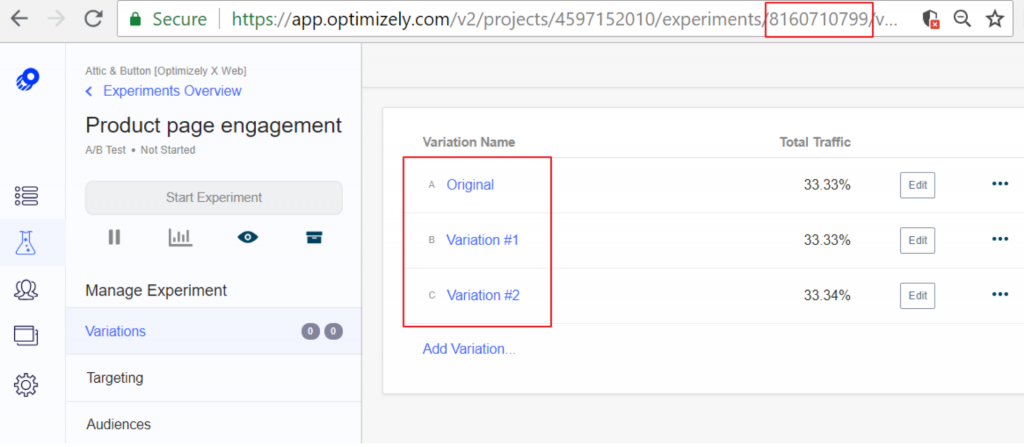
It would help to make data-backed changes instead of going with gut feeling or instincts.
You can check out our detailed guide on the survey errors you should avoid to create flawless surveys and collect valuable feedback successfully.
What to Do With the Customer Exit Survey Data?
Now that you have the data from the leaving customers, it’s time to put it to use. You can create different frameworks to analyze and interpret the survey data.
Retain Customers
The most obvious step after collecting the feedback is to use it to retain the customer. You have the data about their overall experience, frustration points, and other issues with your products and services.
Let your marketing and retention team use these insights to build a personalized proposal to try and retain the customers.
Here’s what we do at Qualaroo:
- When the customer submits the customer exit survey, the data is routed to our CRM and sales Slack channel.
- Our team picks it up and adds tags to the feedback, such as HVC, payment failure, critical, etc.
- The marketing team picks it up on priority to analyze the feedback.
- The team then contacts the customer to open a conversation and learn more about their issues.
- A strategy is built and discussed with the relevant departments, and we follow up with the customer to resolve their concerns and win them back.
You can implement such a loop at your end. Remember, time is of the essence. And if the customer is a high-value user, it automatically takes priority over others.
Build & Improve the Predictive Analysis Model
Predictive analysis can help to track customer attrition and prevent it in the long run. The model utilizes the experience scores from NPS and CSAT data with other factors like engagement level and lifetime value to identify the customer at risk of exiting.
For example, here is a simple predictive analysis model from MonetizeCX to track churn probability:
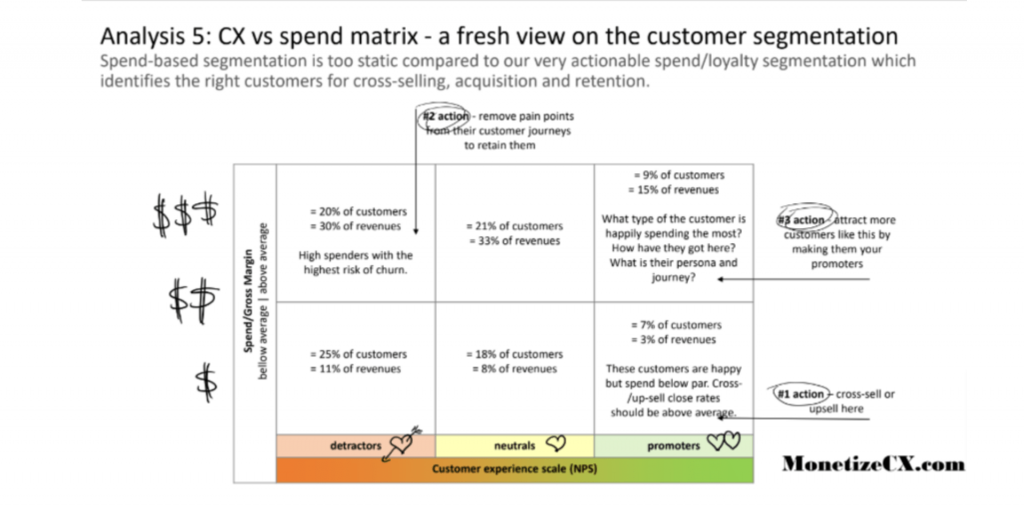
- The team built a CLV-NPS matrix to find customers at risk of churn.
- For example, if a high-value customer gives a low NPS score, it means they are unhappy with some aspect of the product or service. Thus, this customer is a flight risk.
- The team would then follow up with the customer, address their concerns and improve customer satisfaction.
Read More: Customer lifetime value - A complete guide
To refine the model, you can cross-reference the responses from the exit survey questions with your CX data to track high-risk factors contributing to churn.
For example, suppose you are focusing on high-value customers, in that case, exit survey feedback can help you understand why these high-spending users leave your business.
Case Study: Cognizant helps its client reduce churn by using predictive analysis.
A software company struggled to retain customers due to a lack of a central repository for transactions and past behavioral data. So, they approached Cognizant to devise a solution to track churn probability.
Cognizant’s team used machine learning (ML) and the company’s analytical model to get a 360-degree view of the customer journey.
The team focused on high-value customers and channeled their transactional history, feedback, and other behavioral data from multiple sources into one central database.
Then, Cognizant used the big data analytical engine to determine churn probability across 15000 customers and 20 product types.
Optimize the Customer Exit Flow
Analyze the following questions:
- When a customer fills out the survey form, how long does it take for your team to act on it?
- Are there any measures in place to make them reconsider their decisions before they hit the unsubscribe button?
- How can you improve your customer exit flow?
Most of the time, people leave when they have no choice left. This is especially true in the case of SaaS-based products.
So, use customer exit survey questions to design proper cancellation flows based on customers’ actions and concerns and stop them from leaving.
Here’s a suitable example from Asana, a work management platform:
- The platform presents a multiple-choice cancellation form to customers who want to cancel their subscriptions to understand why they are leaving.
- When the customer submits the form, Asana provides a counteroffer to upgrade or downgrade the plan based on the user’s product usage.
- It’s a critical step to show the benefits of your products and stop people from unsubscribing.
- If the customer still cancels their account, the team contacts them to try and retain them.
Here are a few other options for designing an optimized cancellation flow:
- Add an option to pause the account instead of deleting it to get some time to connect with the customer.
- Use a branch survey and request a meeting before they cancel the services.
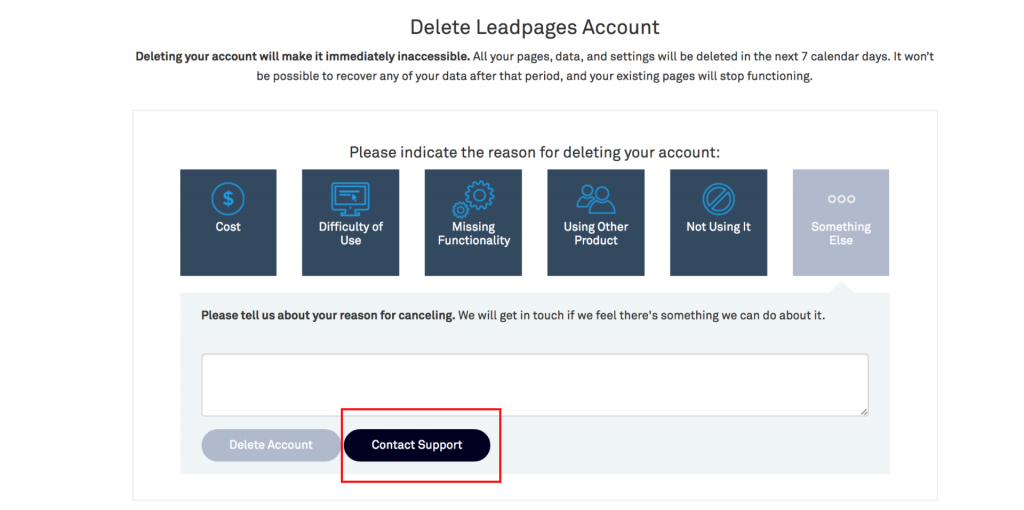
- Present the offer to change the plan or provide customized pricing.
Leverage Exit Survey Questions to Improve CX & Promote Growth
With everything said and done, you still need a proper feedback tool to maximize ROI on your customer exit surveys.
That’s the challenging part, isn’t it? Well, here’s our advice.
Choose a tool that gives you access to multiple channels for targeting the churned customers. The customer may abandon the first survey. But if you can contact them on other channels like email or SMS, it would increase the chance of getting a response. A multi-channel tool will also help to keep the feedback data in one place.
What’s more, dedicated feedback tools come with an extensive template library to help you choose the right customer exit survey questions.
Lastly, ensure the software has an in-depth reporting section and analysis techniques. It would help extract insights from feedback so you can act quickly.
For example, Qualaroo employs an AI-based sentiment analysis engine to dig through the feedback in real time. Plus, you can generate detailed reports to study and analyze individual responses from existing customers to plan your counter-proposal.
With that, you are set to design your customer exit survey campaign and bring back the lost customers. Happy Surveying!
 Tips
Tips
We’d love to hear your tips & suggestions on this article!
FREE. All Features. FOREVER!
Try our Forever FREE account with all premium features!

 We'd love your feedback!
We'd love your feedback! Thanks for your feedback!
Thanks for your feedback!

